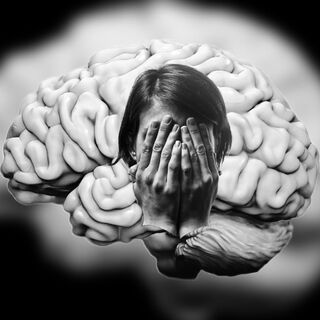Anxiety
Inside the Socially Anxious Mind: Shame
A recent review shows shame is at the core of social anxiety disorder.
Posted July 4, 2022 Reviewed by Jessica Schrader
Key points
- SAD is a condition characterized by fear of rejection, humiliation, or any negative evaluation from others.
- Whether the audience is present or imagined, a socially anxious person feels panic.
- A socially anxious person engages in elaborate post-event processing, analyzing the event in a distorted way.

Social anxiety disorder (SAD), sometimes referred to as social phobia, is a chronic condition characterized by fear of rejection, humiliation, or any negative evaluation from others. Some people from collectivist cultures may even have a debilitating fear of offending others, for example, offending others by emanating noxious body odors. As a result, the sufferer avoids many social situations where they believe they would encounter such negative assessments. SAD is the fourth most common psychological disorder, with a 12-month prevalence rate of 6.8 percent in the U.S. (1) and 2.4 percent globally (2). The prevalence is lowest in low-lower-middle income countries and the African and Eastern Mediterranean regions and highest in high-income countries and the American and Western Pacific regions. More than 90 percent of sufferers report psychosocial impairments, and more than one-third report severe impairments (1). Many people suffer from non-clinical or subthreshold social anxiety, negatively affecting all aspects of their lives. Patients with SAD are biased to underestimate their performance and overestimate the likelihood of adverse outcomes.
As long as there is a perceived audience, socially anxious people can panic. The audience can also be imagined. An anxious person walking in the park may believe that the man sitting on the bench thinks their thighs look huge in their tights. A worried worker delivering a presentation for a work meeting believes that all attendees have noticed their red cheeks and therefore judged them as too nervous. A young female avoids going to her high school reunion because she is too afraid that others will think she is a failure, silly, boring, or incompetent as soon as she opens her mouth at the party. A shy student is too worried about rejection, so he drops the class as soon as the teacher announces that group projects will be required.
The common thread across many stories of socially anxious individuals is that they avoid many life situations, which lead to living a "diluted life." They do not want to attempt any situation they believe will contain any chance of humiliation. They typically repeatedly play out the social scene of the future social experience in their mind—often in a distorted way. Socially anxious individuals generate strong, vivid negative images and import them into new social situations. The socially anxious person believes that the audience has high expectations and they cannot competently fulfill these expectations with their inferior performance. In sum, they build a strong case for avoiding that event.
In addition to pre-event over-processing, they also engage in post-event processing (PEP). When the anxious person finally decides or is forced to enter a social situation, they repetitively reconstruct the memory of the encounter in very distorted ways. Each repetition in this PEP is associated with an increase in negative self-evaluation of social performance. PEP provides a sturdy bridge between past assumed failed social encounters and future cases to keep avoiding social situations. In addition, not only do socially anxious people fear negative evaluations, but they also fear positive evaluations (FPE). They fear these positive evaluations may lead to negative evaluations in the future. The affected person worries that if they collect positive evaluations, this may compromise their relationships with others or increase future expectations of them. Any successful social interaction is viewed as a "one-off" and unlikely to happen again in the future, but at the same time, it increases others' expectations. Lastly, socially anxious people suppress any emotions that they believe would lead to jeopardizing their relationships with others or displeasing them.
Swee, Hudson, and Heimberg (3) recently added a crucial element to understanding social anxiety disorder. Their review of many articles revealed a reliable positive correlation between social anxiety and shame (35 out of 37 studies). The authors state, "the conceptual overlap between SA and shame is substantial, and it seems highly unlikely, perhaps even impossible, to experience significant SA, and certainly diagnosable SAD, without experiencing some level of shame." (p. 2). There are many links between shame and social anxiety: both are associated with early adverse experiences, controlling parenting style, perceived low social rank or image, promoting post-event processing, being self-conscious, negative self-evaluation, and avoidance of situations.
Furthermore, shame reduction is associated with successful cognitive-behavioral treatment (CBT) of SAD. A recent study found that shame significantly decreased over the course of internet-based CBT for SAD (4). The link between the reduction in shame and treatment of SAD has been shown across cultures in Korean and Iranian samples. These recent findings compel mental health professionals to include shame reduction in their treatment protocols for social anxiety disorder. For example, cognitive restructuring exercises via the two-chair technique are part of CBT for SAD. In anxious self/coping self-dialogue, similar to two chair method (5), patients engage in a two-sided dialogue with themselves. Addressing shame and self-criticism can be part of this dialogue. Also, the therapist should directly address and identify negative automatic thoughts and raise the patient's awareness about the link between these thoughts and shame. Shame thrives in secrecy and in the dark. Bringing what the patient believes is shameful to the light will reduce its power. Finally, a person suffering from social anxiety and shame can benefit from learning self-compassion.
To find a therapist, please visit the Psychology Today Therapy Directory.
References
(1) Kessler, R. C., Chiu, W. T., Demler, O., Merikangas, K. R., & Walters, E. E. (2005). Prevalence, severity, and comorbidity of 12-month DSM-IV disorders in the National Comorbidity Survey Replication. Archives of general psychiatry, 62(6), 617–627. https://doi.org/10.1001/archpsyc.62.6.617
(2) Stein, D. J., Scott, K. M., de Jonge, P., & Kessler, R. C. (2017). Epidemiology of anxiety disorders: from surveys to nosology and back. Dialogues in clinical neuroscience, 19(2), 127–136. https://doi.org/10.31887/DCNS.2017.19.2/dstein
(3) Swee, M. B., Hudson, C. C., & Heimberg, R. G. (2021). Examining the relationship between shame and social anxiety disorder: A systematic review. Clinical psychology review, 90, 102088. https://doi.org/10.1016/j.cpr.2021.102088
(4) Wang, H., Zhao, Q., Mu, W., Rodriguez, M., Qian, M., & Berger, T. (2020). The effect of
shame on patients with social anxiety disorder in internet-based cognitive behavioral
therapy: Randomized controlled trial. JMIR Mental Health, 7, Article e15797.
https://doi.org/10.2196/15797.
(5) Hope, D. A., Heimberg, R. G., & Turk, C. L. (2019). Managing social anxiety: A cognitivebehavioral
therapy approach (3rd ed.). New York, NY: Oxford University Press.


